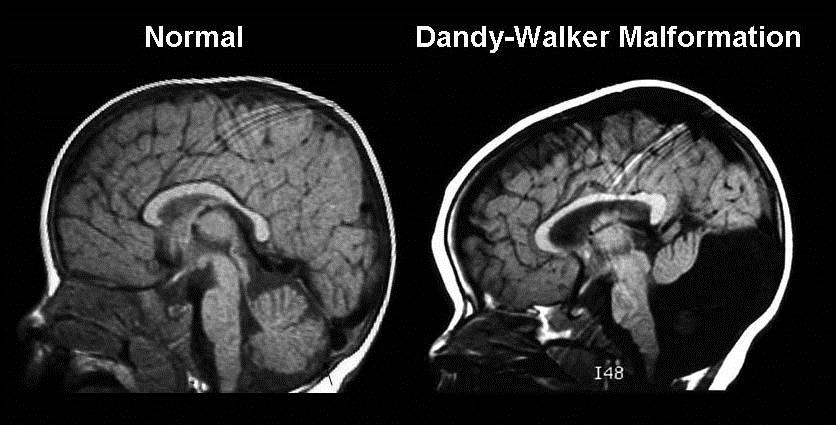If you have ever heard the term Dandy-Walker Syndrome, you probably wondered what it was. The oddly named condition is actually referred to as a complex or malformation. It is named after the two doctors who discovered it in the 1900s and attributed the symptoms and signs of the condition. Doctor Walter E. Dandy and Dr. Arthur E. Walker worked together and found the congenital malfunction of the brain that involves the cerebellum and the fourth ventricle. DandyWalker Syndrome will affect about one in every 25,000 births. More women than men suffer from this condition.
What Is Dandy-Walker Syndrome?
Because it is congenital, meaning it is present at birth, anyone who has this malfunction is born with it. The exact condition affects the cerebellum, which is at the back of the brain and it controls our movements, and the spaces around it that are filled with fluid. The fourth ventricle is enlarged and there is an absence in the brain of the two cerebellar hemispheres. There is a cyst that usually forms in the lowest part of the skull. There could be an enlarged area in the amount of fluids that surround the brain as well as an increase in pressure.
Symptoms of Dandy-Walker Syndrome

While most people are diagnosed when they are from 3 to 4 years old, the span of time before a diagnosis could range from 9 months to 12 years old.
Symptoms That an Infant May Develop
- While still an infant, many patients may have an enlarged skull and display slow motor skills.
- Generally 80% have a normal ventricle when they are born but by the time they have reached one year old their lateral ventricle will have enlarged to more than 10 millimeters. This is known as ventriculomegaly.
- In addition, the patient may have hydrocephalus which is the result of an increased cerebrospinal fluid that gathers in the brain. It is found in around 90 percent of patients when they are diagnosed.
Symptoms That an Older Child May Develop
- When patients are older children and diagnosed with Dandy Walker Syndrome, they exhibit symptoms such as convulsions, vomiting and irritability because of the pressure on the brain.
- They also have a lack of coordination with their muscles and are unsteady with jerky motions with their eyes.
- They usually have a larger head and the back of their skull may be bulging.
- In additions they may have an abnormal breathing pattern and trouble controlling the nerves in their face, neck and eyes. They may even have other problems with their central nervous system that includes the lack of corpus callous and the heart, face, fingers, toes and limbs may be malformed.
How Do People Get Dandy-Walker Syndrome?
While most experts cannot come to a definite conclusion as to what exactly causes people to get Dandy Walker Syndrome, they have a few ideas that could potentially be the reason. They include:
- Defective chromosomes that interfere with the development of the brain while a fetus
- Specific viruses that a mother may have while pregnant that are passed on to the baby
- Certain toxins or medications that have been exposed to the unborn child
- Diabetes from the mother.
While there are some cases where more than one person in a family has developed Dandy Walker Syndrome, it is not normally a condition that is passed down throughout a family. There have been a small amount of cases where it has been determined, it ran in the family but those are rare cases. They may have been exposed to the same conditions rather than have it in their genes.
How Is Dandy-Walker Syndrome Diagnosed?
Because this condition is congenital, it can be displayed through an ultrasound around 12 to 14 weeks after conception. Usually an ultrasound at 18 weeks or later is more accurate in determining the condition. An amniocentesis, which analyzes the chromosomes of the fetus, is also used in the diagnosis.
Once the baby is born, diagnosis may be considered if the child is displaying neurological or physical signs. At this point a magnetic resonance imaging, or MRI, is needed to take images of the brain or a computed tomography, CT, scan is used.
Treatment for Dandy-Walker Syndrome Diagnosed
1. Ventriculoperitoneal Shunt
Once the patient has been diagnosed with Dandy Walker Syndrome, the main treatment is a ventriculoperitoneal shunt. A neurosurgeon puts one end of a little tube into a ventricle that is in the brain. The other end of the tube is placed under the skin and runs down to the abdominal cavity. This helps the excess fluids to be redirected to the abdominal cavity where the body will reabsorb it.
2. Endoscopic Fenestration
Another option is an endoscopic fenestration. This calls for a small flexible device that is placed in the brain and the surgeon makes an opening between the third or fourth ventricle at the base of the brain in order to equalize the pressure from the excess fluids that run through the central nervous system.
3. Other Treatments
Additional treatments could include anti-seizure medications to treat hydrocephalus and cerebellar agenesis symptoms. For help with neuromuscular, symptoms physical or occupational therapies may be utilized.
